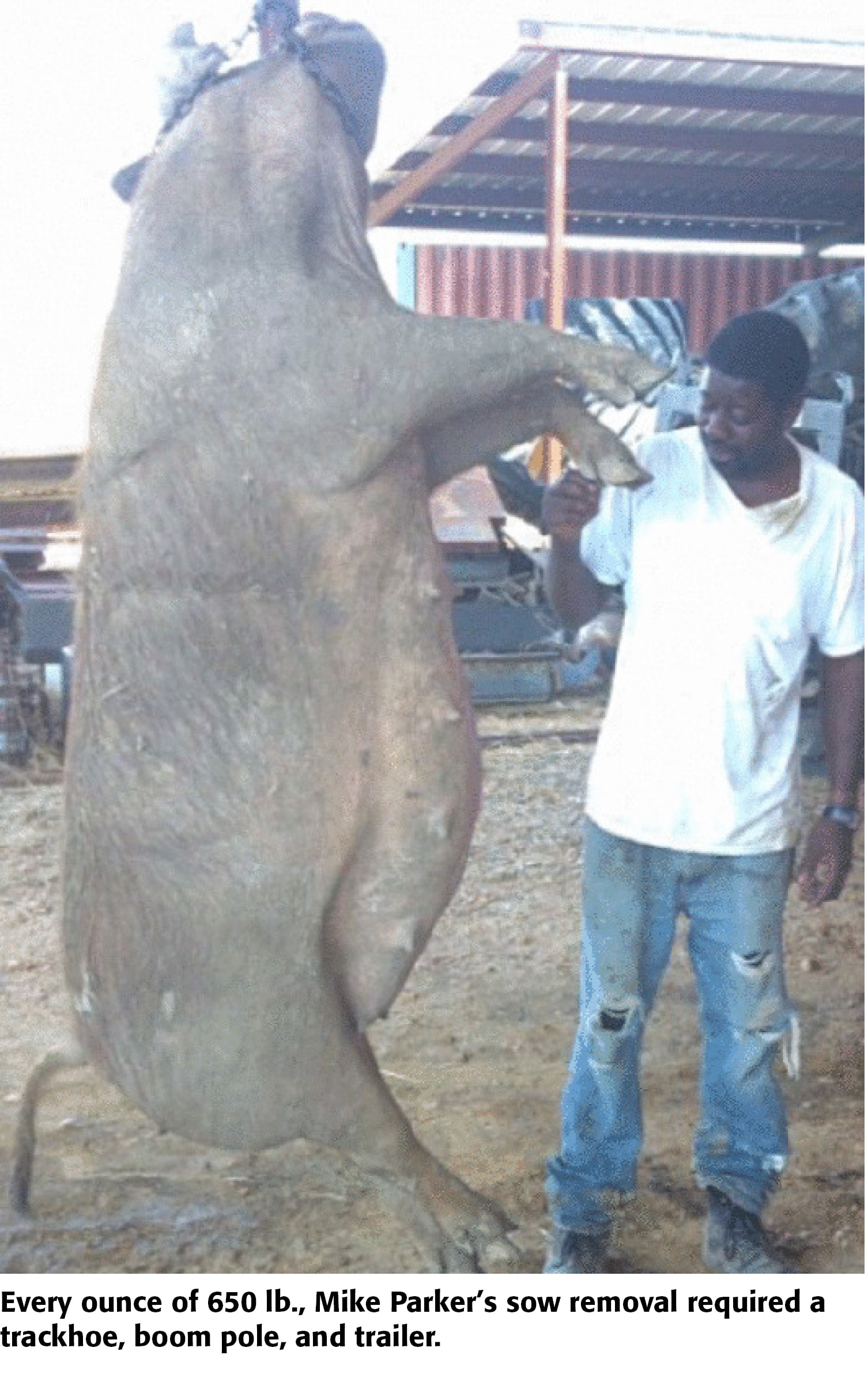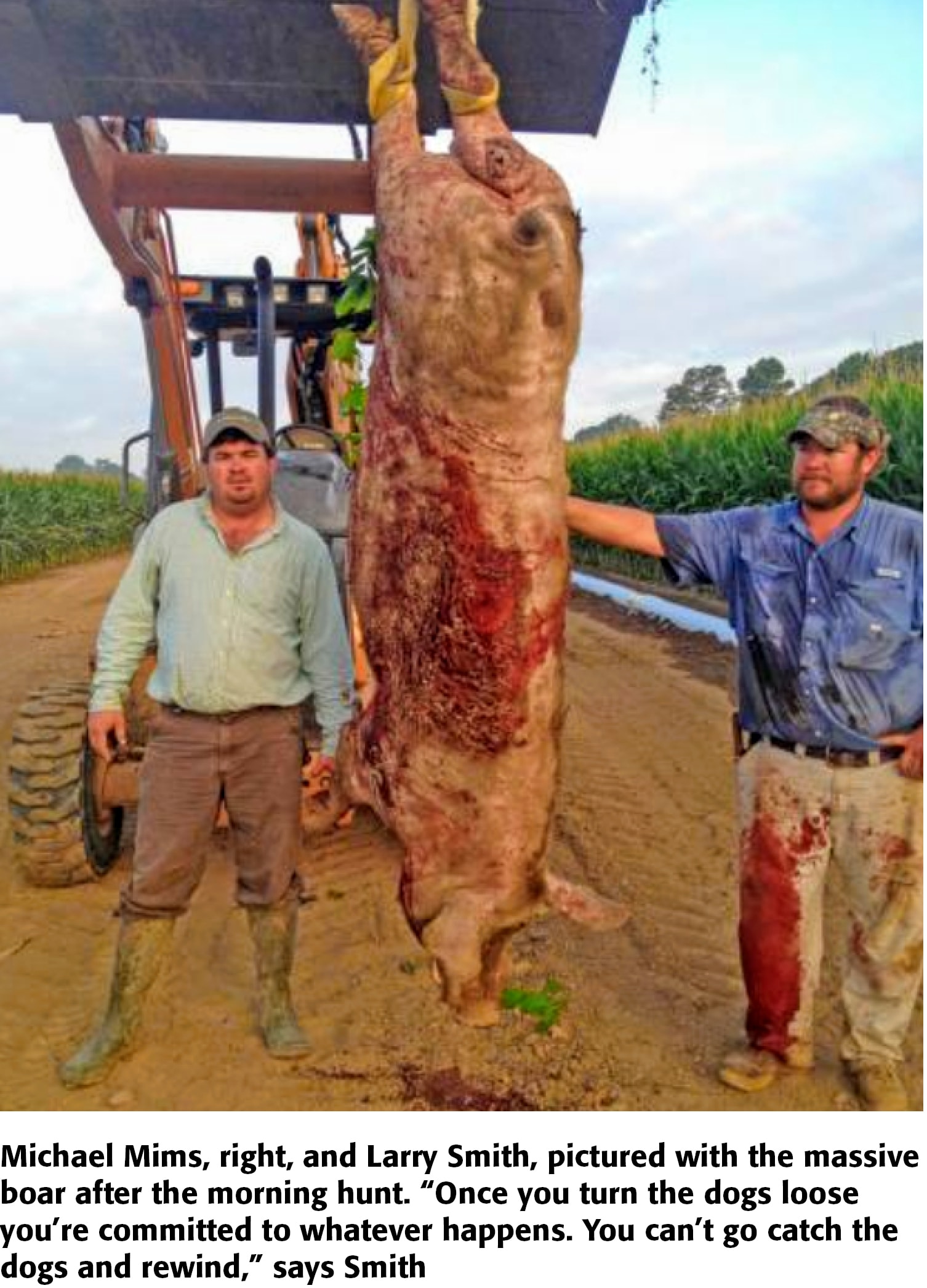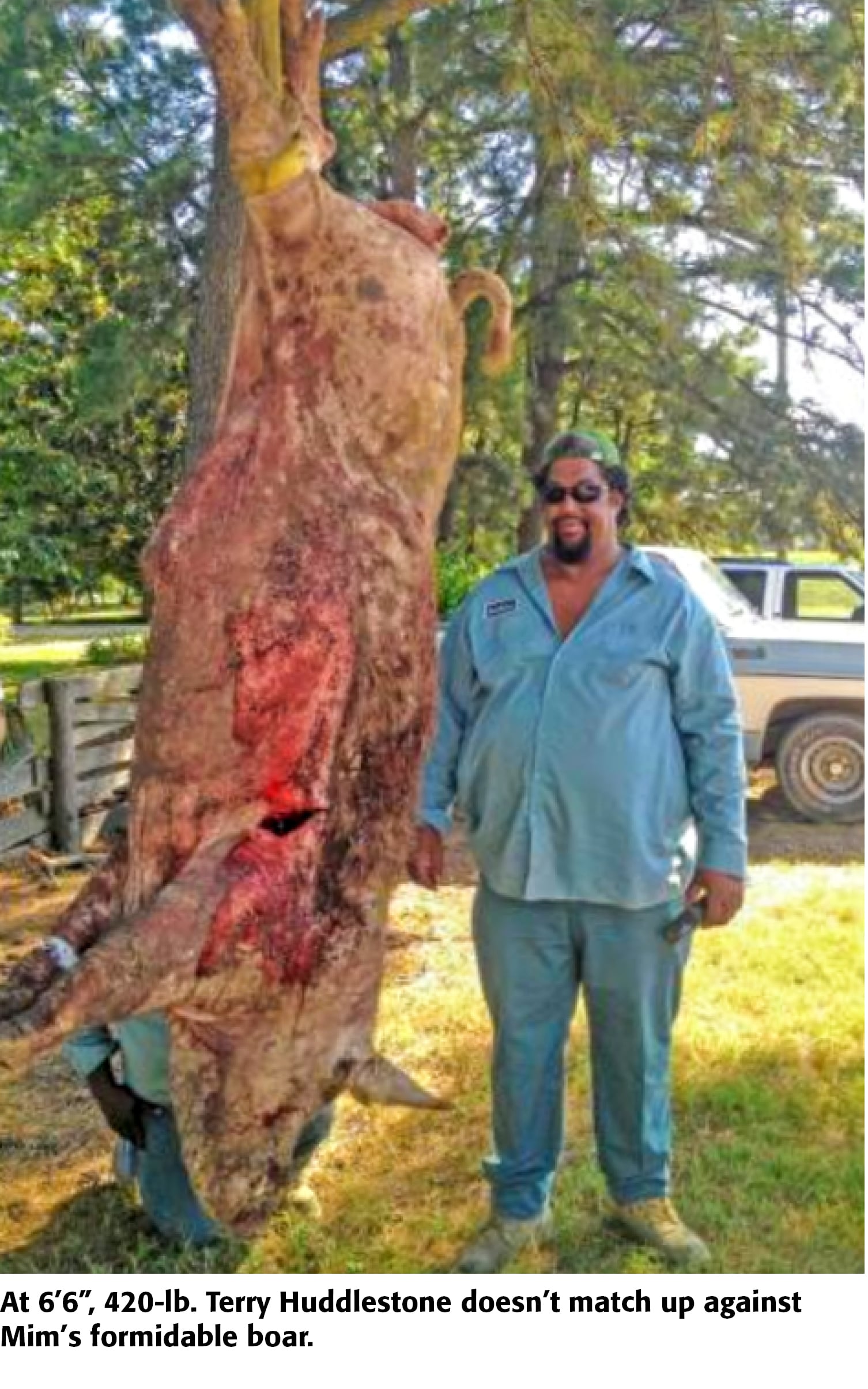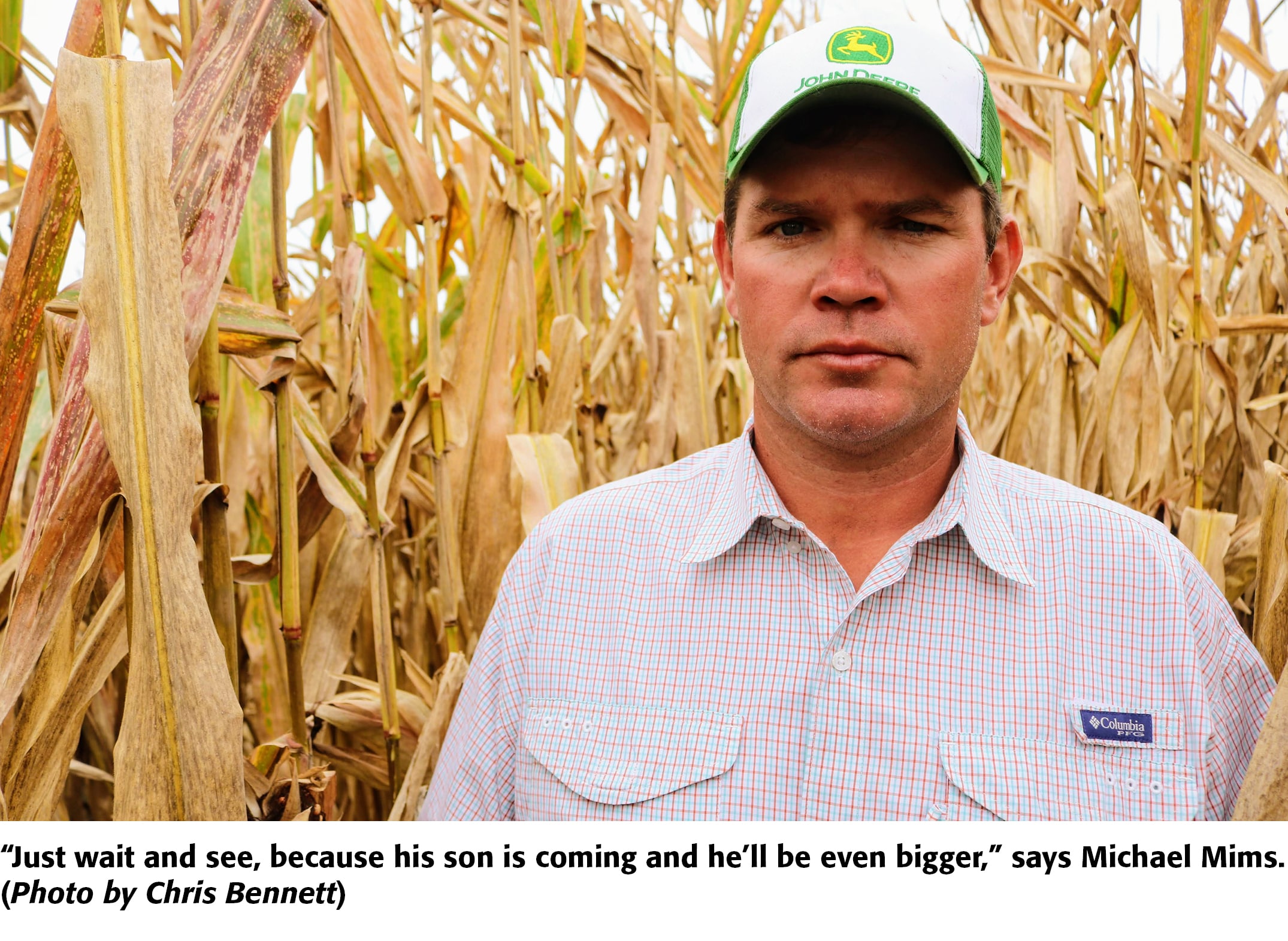Flashback: Killing Hogzilla the Monster Wild Pig

Michael Mims charged across a turnrow and burst through a green wall of July corn, running toward the baying bedlam of a primal melee. Tangled leaves slapped his face as he pounded down the mocha dirt of a Delta middle, primed to break through an 8-foot curtain of stalks and reach the source of absolute chaos. Twenty-five yards into the field, he checked up and froze in surprise as the flailing body of a black dog catapulted upward from the corn, arced 5 feet above the canopy, and sailed across his sight line before crashing into the foliage. Adrenaline surging, he steeled his nerve, fingered a bowie knife strapped against his thigh, and broke through one last row before spilling onto a flattened pocket 30 yards off the turnrow. Less than 6 feet away stood a hulking leviathan, a 750-lb. wild pig slinging teeth and wearing five dogs. Sliding a 15-inch blade from its sheath, Mims waded into a surreal brawl of blood and dirt—unaware an extraordinary wild pig saga was only just beginning.
Roughly 6.3 million wild pigs tear through $2.5 billion in damage to the U.S. economy every year, and almost $1 billion of the tab is exclusive to agriculture. Ignoring the most reproductively-capable large animal in North America is tantamount to financial disaster on many farms. Trapping and tracking techniques vary, but when a hogzilla walked out of fantasy and into farming reality in Tallahatchie County, Miss., conventional hunting wisdom was turned on its head. The pantheon of wild pig hunts is filled with unusual narratives, but the chase for a 750-lb. beast hiding in plain sight at Due West Farms ranks as a standalone account. Farming reality outshines fiction—just ask Michael Mims.
When a grower needs wild pig relief in the Mississippi Delta, Mims’ reputation often takes the day. He wears four hats as farmer, agriculture consultant (Mims Ag), Dogo breeder and hog hunter extraordinaire. A son of Leflore County, Mims, 37, has hunted wild pigs since college, averaging over 450 kills per year. He hunts intermittently year-round, but runs dogs four days a week from February into March, sometimes for pay and sometimes for the hunt. “Farmers call me with pig problems and if I get too loaded, I’ll bring in my hunting buddies from Arkansas, Mississippi or Alabama. It equals out to about 80 dogs available if needed.”
“I can’t help but love hog hunting, and sometimes, I especially love hunting alone. It’s just being with my dogs, working together as a team. I watch and teach, and see how good we can get. How good of a pack can I put together?”
From a ringside seat, Mims has watched Mississippi’s wild pig population explode. In the 1980s, roughly 5 percent of Mississippi’s land area had wild pig presence. As of 2017, at least 50 percent of Mississippi land has sustained wild pig presence translating to a total population of over 200,000. Mims and his dogs are in high demand. “We’ve got some farming areas where hogs are sometimes the No. 1 crop problem. I’ve seen 30 acres of planted corn gone in one night—looks like it’s been bulldozed. Do the math. The money lost by a farmer to hog damage can be a total catastrophe.”
The Ghost Pig
In 2011, Mims heard several anecdotal accounts of a massive pig roaming farmland, but the tantalizing stories didn’t progress beyond hearsay. In adjoining Sunflower County, a farmer and friend of Mims, Mike Parker, was checking irrigation in July when he spotted a 350-lb. boar leaving a soybean field. He reached for a 7mm rifle and shot the pig, only to watch it rumble into bean cover.
Parker hopped on a four-wheeler and eased into the rows, searching for the wounded animal. In the middle of the field, he spotted an enormous pig bedded down, far larger than the boar he had just shot. “It was a sow and the biggest hog I’d ever seen. I eased up behind and shot her,” Parker recalls. Every ounce of 650 lb., the sow’s removal required a trackhoe, boom pole, and trailer.
Parke

r’s kill was a domestic pig gone feral, and it spurred Mims to continue hunting for the rumored colossal boar. Mims repeatedly loaded his dogs and rode every turnrow in the area, looking for signs of the giant pig. The farm fields, bottoms and cane breaks were silent. The 750-lb. wild pig, if it existed, had seemingly vanished.
For two solid years, Mims searched for the ghost pig. No sign; no gargantuan wallow; no trail camera evidence; and no confirmed sightings of a behemoth. But Mims took Parker’s sow-kill to the bank, and waited for a window to open, convinced the boar was hiding in a bayou or patch of woods. “Mike’s sow looked like a baby hippo, but this boar was supposed to be much bigger. I asked everyone I came across, ‘Have you seen big tracks? A big hog?’ Nothing.”
With the trail stone-cold, he assumed the pig had died—until a phone call on July 12, 2013. Working in his farm shop, Mims’ cellphone rang, with producer Larry Smith, farm manager at Due West Farms in Glendora, on the line: “He’s in my corn.”
Cob, Stalk and All
Earlier in the day, driving a turnrow at first light, Smith saw a dark mass emerge from 2,000 acres of corn cover. Standing broadside 50 yards down the turnrow, silhouetted against an early morning sky, the figure had the body of a pig, but the proportions were extreme—couldn’t be right.
“Holy s***. What is that?” Smith exclaimed. He grabbed a .45 pistol and leaned out the truck window, firing several shots as the pig wheeled and disappeared into the canopy.
Smith hustled down the turnrow, but saw no blood. After a few minutes of scouting inside the field, he found clear signs of a monster pig interested in far more than cob consumption: “This hog was clearing the field. He was eating up the entire plant. I’m talking cob, stalk, and all. I’d seen hog damage, but I’d never seen nothing like this,” Smith says.
Based on the sighting location and the razed area of ground, Smith mentally marked an 80-acre section where the net would be cast. He reached for his cellphone and dialed Mims. The hunt for a white whale was on.
Flesh on Flesh
Mims began making calls and gathered a team to hunt the next morning. With the pig’s immense dimensions confirmed, he was sure it was a pen escape, essentially a farm pig gone wild, and the implications put Mims on edge. “It meant this had to be a tough, tough hog. For a pen hog to grow this big and go this many years without getting caught, it meant he had sharp intelligence and knew how to keep out of sight. I didn’t want any of us getting hurt and I sure didn’t want my dogs getting killed.”
At 5:30 a.m., Saturday, July 13, Mims and his crew pulled up beside the corn field in a fleet of side-by-sides and four-wheelers, with four curs as bay dogs, and two pit bulls, Spook and Diesel, as catch dogs. Based on Smith’s encounter, Mims believed the pig was probably bedded down within or close to the 80-acre vicinity. With an endless corn buffet, plenty of cool irrigation water and a curtain of cover, the pig had no reason to leave.

The curs were medium-range trackers, capable of handling a scent several hours old. When Mims opened the gate on several dog boxes, the four curs shot into the field, and a symphony of teamwork began. Dressed in summertime hog-hunting attire—a loose-fitting shirt, light-weight Carhartt pants and old tennis shoes, Mims was ready to give chase. He stood beside a Polaris Ranger, alongside his two leashed catch dogs, and waited. Dogs and master alike leaned toward the field, straining for the sound of the first bay. “I was on edge holding the pits because I knew it was going to be rough. Once the pits catch, you have to get there as quickly as possible so the dogs don’t get killed. Waste time and your dogs die.”
Fifteen minutes later, 100 yards into the field, the curs opened up in a bawling concerto. Smith’s father, Larry Smith, Sr., was standing on a field corner when the enormous boar broke from an end row and roared out of the corn, scattering several men like bowling pins across the turnrow. “He was looking like a horse,” Smith, Sr. remembers. “That hog about ran on top of me. You ever seen a fat, 65-year-old man run?”
Smith was left blank, almost as if reality was suspended: “He came outta the corn and I really didn’t have any reaction. It’s a hard-to-explain feeling. Once you turn the dogs loose you’re committed to whatever happens. You can’t go catch the dogs and rewind. It’s just on and something is going to happen.”
As the boar turned and stormed back into the field, curs on his heels, Mims released the pit bulls and followed the pair into the cover. In a flash, six men, six dogs, and one boar were swallowed by corn, leaving behind clouds of dust on a suddenly still turnrow. But inside the rows, a battle royal was in session, punctuated by a cacophony of crashing corn, grunts, squeals, growls, bawls, and combat-grade profanity, all bursting over the canopy in bizarre harmony. Flesh on flesh, the hunt for Hogzilla was going primal.
Guns and Regrets
Six months prior, Mims lost a dog when it was killed by a careless hunter during a bay. Temporarily, Mims stopped carrying guns during hunts, relying entirely on 12 to 15 inch double-edged blades. But when a wild pig grows big enough, certainly at 750-lb., dogs cannot hold such a beast. Mims was chasing the titanic boar with no gun and he quickly regretted the decision.

Twenty-five yards into the field, Mims had almost reached the fight when he saw Spook shoot over the canopy with limbs splayed, tossed by the boar. A few steps later, Mims caught sight of the largest wild pig he’d ever seen in his life. “When you see this hog, you think it ain’t real; ain’t happening. It looked like something from another world and I was afraid we were all fixing to get killed,” Mims exclaims, “This s*** got real fast.”
“I’ve seen a hog cut down five dogs in less than 30 seconds, and that was just a 140 lb. hog with inch-and-a-half long teeth. Nobody realizes how fast they are. They fight from the time they’re babies, geared to survive no matter what. Those teeth are razors and they hit where they aim.”
Spitballs and Diesel
Scrambling back from his airborne trip across the corn canopy, Spook returned to the fight, staying on the boar’s ear while Diesel tried to catch. Spitballs off a battleship. No matter how pressured, the boar plowed forward, dragging dogs and men through the field. A porcine bulldozer, draped in six crazed dogs and multiple men, was creeping slow-motion through corn, while Mims and Smith ran alongside, trying and failing to stick a knife through a shield of thick hide.
Beaten off during countless attempts to catch and hold, Diesel changed approaches and darted around behind, latching on to the boar’s testicles. “Diesel bit balls and held on, all stretched out with his paws dug in the dirt. The hog just kept walking and Diesel literally looked like he was waterskiing through dirt,” Mims describes.
Moving with relative ease, the boar again exited the corn, hauling the scrum across the turnrow and over a road. He headed toward a slough pulling a train of dogs and men—mere nuisance baggage—surreally caboosed by a rolling cloud of dust and a waterskiing pit bull.
Hooking Hazard
“If he reached the bayou and got us in water, there was no telling what might happen. The clock was rolling and the longer this went on, it meant my dogs or one of us would get hurt bad,” Mims recalls. “I was trying my best to get a knife in him, but he’d turned twice to bite my leg, and his mouth opened wide enough to drop in a volleyball. If he bit down, he’d snap my leg in two. There’s no room for messing up and no textbook on a hog this size.”
Wild pigs use razor-sharp tusks to hook with extreme accuracy. A hook is akin to a swinging scalpel. Mims’ dogs typically wear protective cut collars or cut vests depending on temperature and time of year. (Mims doesn’t use cut vests in July heat.) A bundle of collars hang on Mims’ shop wall as testament to the dogs he’s lost due to wild pig injuries. The risk to hunters from hooking can be equally high. “A few years ago, I had a hunting friend get hooked in the thigh. A week later the wound threw a clot and he died. The safety of people and dogs are the first things I’m thinking about on a hog hunt. Always.”
End of the Line
After carrying the fight over 200 yards toward the slough, the boar finally slowed and gave Mims opportunity. “Here’s what really got him killed: He started into the bayou and ran into a log jam of limbs and debris. When he stalled, it gave us a real chance to use the knives.”
Mims usually carries a low-cost, generic knife to avoid the expense of broken or lost blades. In standard practice, a catch dog latches on to a pig’s ear or head and a hunter lifts the pig’s back legs off the ground and renders it immobile. “Legging” a pig into a wheelbarrow position allows another hunter to stab into the lungs. Mims’ 15” blade is normally capable of piercing one or both lungs.
However, Mims’ hogzilla was not a candidate for legging. Period. “His back legs were so big we couldn’t get our hands around them. Legging wasn’t happening. Heck, no.”
Despite the pig’s halt, Mims still couldn’t pierce the hide. Mims, 6-foot tall and 290 lb., backed several feet away and put the knife on his hip, preparing to drive the blade in with weight and momentum. The tactic was rash—a broken blade, sliced hand, or a groin injury were all possible. “It’s not a smart move, but I didn’t have any choices left.”

Calm in chaos, Mims turned sideways and ran at the pig, striking just behind the front shoulder with his weight, knife first, and felt the blade pierce through the thick hide and penetrate deeply into a lung. As he yanked out the blade, the rushing sound of escaping air and blood spray followed. Almost at the same moment, on the opposite side, Mims’ father, Gary Mims, broke through the hide into the other lung as the boar instantly collapsed. A two-year hunt for the white whale was over.
Mims checked Spook and the other dogs for serious injuries and found nothing beyond cuts and surface wounds. The dogs’ condition was out of balance, almost inexplicable. A 30-minute fight with a 750-lb. wild pig should have caused far greater harm, probably death, to at least some of the dogs. Mims believes all of the dogs could have died during the fight at Due West Farms, but were spared by an anatomical anomaly: “The hog’s teeth had grown so big they curved inward,” Mims describes. “If he had normal teeth, he’d have killed every dog.”
Scooped into the bucket of a backhoe, Mims and Smith carried the boar back to the farm headquarters and let the Due West farmhands share the meat. (It required three men to lift the head.) Lodged in the rib cage was a .45 bullet. Standing on the turnrow the previous day, Smith had shot accurately from distance, but with little effect.
Smith carries a single regret related to official weight. “I still get asked over and over about the size and weight. It was so big—so big. I wish we’d have weighed it properly because I have no problem believing it was way over 750 lb. I’d have no surprise if it really was 800 lb. or even a little more.”
Waiting on the Son
Mims keeps a full shoulder mount in his shop as a perpetual reminder of the most surreal wild pig hunt of his life. “This hog was no legendary trophy. He was a domestic farm pig gone wild. But people don’t understand the damage a hog this size does to crops. They’ll also never realize the fight we all went through that day. It was like a crazy movie come to life,” Mims explains.
“I have no desire to ever tangle again with a hog that size,” Smith adds. “I don’t want to catch anything any bigger.”
Is there another Hogzilla in the corn? Another white whale to chase? Indeed, insists Mims. “That hog ran for at least 10 years and spread his genes everywhere. His son is out there. Just wait and see, because his son is coming and he’ll be even bigger.”
For more, see:
Against All Odds: Farmer Survives Epic Ordeal
Wild Pig Wars: Controversy Over Hunting, Trapping in Missouri
Agriculture's Darkest Fraud Hidden Under Dirt and Lies
Blood And Dirt: A Farmer's 30-Year Fight With The Feds
Killing Hogzilla: Hunting a Monster Wild Pig
In the Blood: Hunting Deer Antlers with a Legendary Shed Whisperer
Living the Dream: Honoring A Fallen Farmer
Pigs Don’t Fly: Feral Hog Spread Is A Man-Made Mess
Hemp Fraud Hits Farmer With Clone Scam
Seeds of Discord: Crossing the Great Cover Crop Divide
The Living and the Dead: Black Vultures Expand, Farmers Pay Cost








